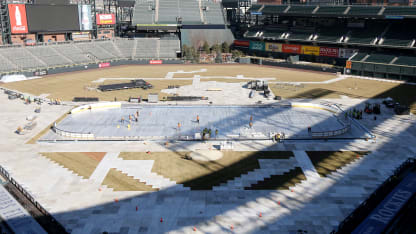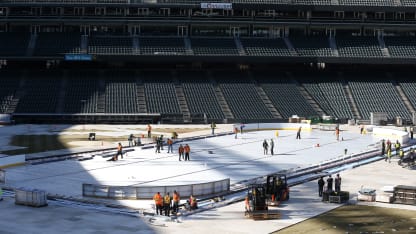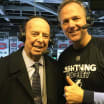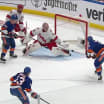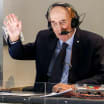Large tiles for foot and vehicle traffic protect the playing field.
"We're guests in somebody else's home and we appreciate the grounds crew and what they do, so we try and treat that with as much respect as possible," Craig said.
The rather balmy weather projected for the next several days is fine for everything but making ice, Craig said, which is why that process will take place at night, starting Saturday.
The refrigeration unit pumps as much as 3,000 gallons of glycol coolant into the aluminum trays. The glycol chills the trays to keep the ice surface temperature 22 degrees Fahrenheit. Approximately 20,000 gallons of water are required to create a 2-inch thick ice surface.
"It takes a long time to get the correct thickness," Craig said. "It takes at least eight hours to build a quarter-inch of ice. We'll spray very fine layers of warm to hot water to ensure a good density."
Craig said the ice will be ready in time for the University of Denver and Colorado College teams to use for practice next Friday. They will play the following night.
"While it's nice out, we have thermal insulated tarps that we put down [to protect the ice]," Craig said. "We try and be patient during the day. Once the sun goes behind the stadium and it gets shady, we'll pull those up."
A monitoring system in the ice will enable Craig to keep tabs on ice temperature and other conditions necessary to maintain a good playing surface. A weather station is set up on the outfield grass.
Craig said the mile-high altitude and low humidity aren't expected to cause any problems.
"We have some NHL buildings that work in very dry climates, so we do a few different things to condition the ice," he said. "We'll take those lessons and apply them here if we have those kinds of conditions. When you're monitoring the ice, you're looking at the temperature of the ice surface, the temperature of the air, the humidity. All of these have a direct relationship with each other and we know how to deal with it."
Craig said the ideal outside temperature for the 2016 Coors Light NHL Stadium Series Game would be "a little above freezing, but we've dealt with everything. You also want it to be good for the fans.
"When you look at the weather history in Denver, we're basically over 300 days of sunshine a year, so it was decided that a nighttime game was best for everyone."
The NHL held its first outdoor game at Edmonton's Commonwealth Stadium on Nov. 22, 2003, when the temperature was minus-2 Fahrenheit. Outdoor games have been played in many iconic stadiums, including Fenway Park, Wrigley Field, Michigan Stadium, Yankee Stadium and Dodger Stadium, where in 2014 it was 63 degrees at game time.
